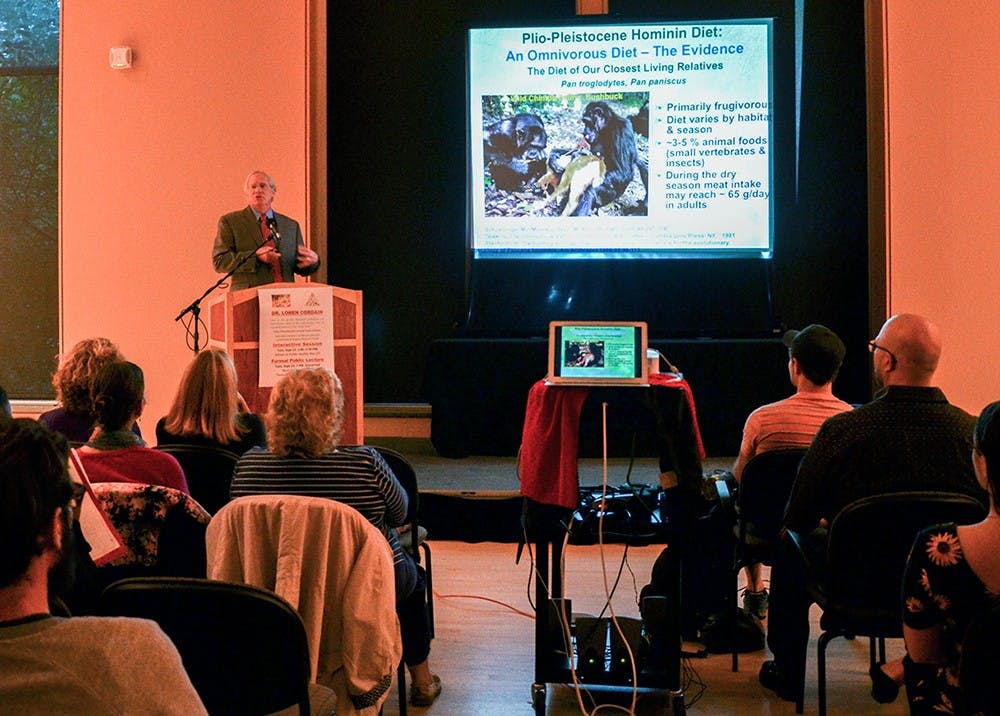“They’re not much bigger than her fists,” said Loren Cordain, the New York Times best selling author of “The Paleo Diet.” “That image was taken by Richard Lee in the late 1960s.”.
Cordain, with a head full of white hair, contrasting with his deep red tie and neat blue dress shirt, stood centered in IU’s Neal Marshall’s Grand Hall.
Surrounded by the room’s beige walls and cascading tan curtains, he began his presentation titled, “Origins and Evolution of the Western Diet: Health Implications of the 21st Century.”
“We will be examining diets starting from five million years ago,” he said.
According to the Paleo Diet website, Cordain became interested in nutrition when his mother encouraged him to eat fruits and ?vegetables.
The room was filled with attendees of all ages.
Students sat cross-legged in the back trying to get the best view they could.
IU juniors Lyndsey Donnar and Christin Miller attended the talk to write down points for their B310 Health Care and Diverse ?Communities class.
“It was in depth and hard to follow at times,” Donnar said. “But once he started talking about high glycemic values, those were things that I knew about.”
Miller said she expected to hear only about nutrition, but was surprised about the historical and anthropological aspects to the talk as well.
Cordain glided the green laser light from his pointer over his presentation. He showed a description of each representation of an ?omnivorous diet.
It included facts from a sabertooth tiger, a leopard and a homo, otherwise known as a Hominin, an anthropological term referring to humans or human ancestors.
Cordain then posed two questions shaping the remainder of his presentation. How much plant food is consumed? How much animal food, food from the body of an animal, is consumed?
Cordain took the room down a historical line of food by analyzing nutrition facts that often aren’t recognized.
“The Neolithic and Industrial era fundamentally changed our diet,” he said.
The Neolithic Revolution sparked the emergence of foods such as sucrose, feedlot-produced meats and ?vegetable oil.
“The Industrial Revolution is what I call the junk food revolution,” Cordain said listing Pringles, M&M’s and cereal among the foods produced within this time period.
Cordain said cereals produce 23.9 percent of the calories in a typical American’s diet.
“Historically, gatherers would not eat grains and grasses because they needed something with more calories to fight starvation,” he said.
However, Cordain points out that cereals don’t carry as much nutrition as are ?expected.
He explained that the lower the glycemic number, the healthier the food.
“Some foods we consider healthy, like Cheerios, have a high glycemic number,” he said. “Therefore, they’re not any healthier than candy.”
Cordain’s research with “The Paleo Diet” focuses on encouraging people to consume modern versions of food based on foods that were hunted and gathered.
These natural foods, whether plant foods or animal foods, aid in a higher protein intake, a low glycemic index and higher fiber, potassium, vitamins, minerals and antioxidant intake, according to the Paleo Diet website.
“I come from Colorado, which has a higher altitude than where you are here,” Cordain said. “In the winter months, we have very few plants because the ground will be frozen.”
The diet compares the positive health values of those living in pre-agricultural times, when people ate and digested whole grains, non-starchy vegetables, fruits and unprocessed fresh foods containing more potassium than sodium.
“This is the message that I’ve been wanting to share over the last 20 years,” he said.






